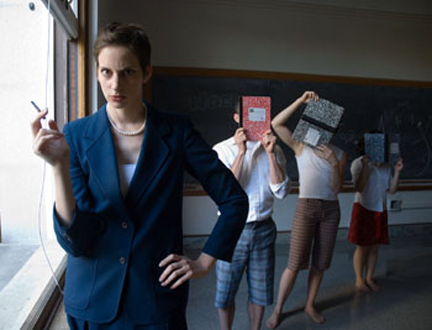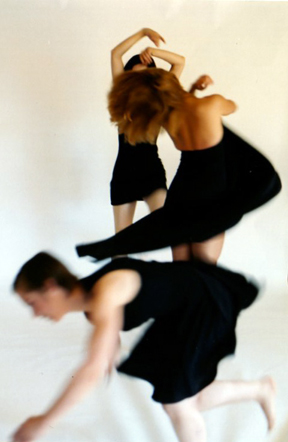Letter from San Francisco No. 14
EmSpace Dance
CounterPULSE
1310 Mission Street (near 9th) in
San Francisco, CA
Courage
Shotwell Studios
San Francisco, CA
by Rita Felciano
copyright ©2006 by Rita Felciano
Humor is a tricky business. To work, it needs an audience with a sense of common values, a sense of normalcy against which an aberration can be played off. We have—at least, I think we do—an implied set of expectations of behavior, of beings. They may differ from person to person, but there exists a common ground on which we all agree to walk. Humor grows out of that territory. That’s why pretense, the putting on of an obviously ill fitting cloak—either too big or too tight, worn to hide inadequacies—is such a popular subject for humor.
In two recent performances, choreographers Erin Mei-Ling Stuart and Todd Courage ventured into that treacherous terrain of trying to make us laugh, hopefully more at ourselves than at somebody else’s expense.
 Stuart has been choreographing for roughly ten years and founded her company, EmSpace Dance, in 2000. She has sharp eyes for looking through facades and punching holds into cardboard defenses. She also has a good grasp at working crisp gestures into amusing vignettes with characters that stop just short of stereotypes. The frumpy high school outcast sneered at by a bevy of glamour pusses. The dowager and the rocker caught in an elevator. The ugly duckling that metamorphoses into a still awkward Odile. Because Stuart has a flair for inventing telling movement, good sense timing and handles comedy with a light touch, the pieces are not quite as sophomoric as they might sound.
Stuart has been choreographing for roughly ten years and founded her company, EmSpace Dance, in 2000. She has sharp eyes for looking through facades and punching holds into cardboard defenses. She also has a good grasp at working crisp gestures into amusing vignettes with characters that stop just short of stereotypes. The frumpy high school outcast sneered at by a bevy of glamour pusses. The dowager and the rocker caught in an elevator. The ugly duckling that metamorphoses into a still awkward Odile. Because Stuart has a flair for inventing telling movement, good sense timing and handles comedy with a light touch, the pieces are not quite as sophomoric as they might sound.
“A Certain Age”, which opened Stuart’s most recent concert is representative of her work. Originally in 2001, “Age” was part of a trio whose sections seemed quite unrelated. I remember one episode of rubber-gloved women playing cards. “Age” survived for good reasons: it’s genuinely funny, relatively nuanced and shows two dancers in delicious synch with each other.
Stuart and Blane Ashby, who has enlivened just about every dance I have seen him in, are dressed in identical black evenings gowns, elbow length whites gloves and yards of shimmering pearls. Suave but ever so blasé concertgoers, they are glued to their chairs, wave and gesticulate to acquaintances with gestures that spin in perfect unison. But soon that controlled symmetry breaks apart; those long fingers turn into claws, the chains of pearls into slingshots and the smiles into snarls. The scenario is obvious but Stuart develops the trajectory expertly. Personally, taking pot shots at classical music goers rubs me the wrong way because the art is so much under attack these days. But in fact, using the excerpt from Bach’s glorious Double Concerto in D Minor introduces a note of absurdity into the piece.
The premiere, “Continuing Education,” also makes good use of more modest music, tailor-made by composer Jonathan Norton who also wrote the fine score for Stuart’s non-comedy “How to See Red.” For “Continuing” Norton created an intriguing assemblage of found material—schoolyard sounds, bells—with composed music, including deadening piano exercises of the Czerny variety.
The setting is an elementary classroom school with small desks facing a projected blackboard, shadowy teacher (Ann Berman) included. Stuart works the non-proscenium stage well. She deployed the dancers along invisible lanes, both horizontally and laterally—in assembly lines, meditation poses, in gym. Those channeling attempts inevitably break down into cheerful chaos when cheerleading lines explode, rhythmic clapping dies and notebooks become projectiles. When the latecomer (Noel Plemmons) plops in like a rambunctious puppy, any hope for order is lost. Spitballs fly, bodies tumble, and the class dolt ends in the corner creating her own little universe. Plemmons’s anarchic counterpart is a delightful, little Miss Goody Two Shoes, Erin Okayama, who jetés and twirls through the melees with a blissfully pasted on smile and an eagerness to please everybody.
Berman, in a severely cut suit, out of which she whips a leg like a switch blade, is splendid as the over-her-head in it teacher. A lithe, very tall dancer she squeezes her mouth into a dried prune when she doesn’t emit silent screams. Fidgety, insecure—she writes cheat notes on her arms—she towers over those kids but finally collapses into sobs and grabs for a cigarette. She is splendid. Stuart drew a humorous, believable character out of a stereotype, one who we can both laugh at and laugh with.
 Courage Group as an ensemble is quite young, though its choreographer Todd Courage has been part of the Bay Area performing scene for many years. He claims twenty-five years of experience as a choreographer but it’s only in the last four or five that his name has begun to appear in a non-dancing capacity on a somewhat regular basis. From previous viewing, confirmed by this latest concert, Courage appears to be fascinated with awkwardness, the inability to fit into a mold—of behavior, of beauty, of identity. He gives his misfits a gangly, gawky movement language, frequently ballet derived. Sometimes this serves his purposes well, but often his choreography simply looks stiff and stripped to the point of nakedness.
Courage Group as an ensemble is quite young, though its choreographer Todd Courage has been part of the Bay Area performing scene for many years. He claims twenty-five years of experience as a choreographer but it’s only in the last four or five that his name has begun to appear in a non-dancing capacity on a somewhat regular basis. From previous viewing, confirmed by this latest concert, Courage appears to be fascinated with awkwardness, the inability to fit into a mold—of behavior, of beauty, of identity. He gives his misfits a gangly, gawky movement language, frequently ballet derived. Sometimes this serves his purposes well, but often his choreography simply looks stiff and stripped to the point of nakedness.
In the recent program, “The blitz: a ballet, sort of” was one of two pieces in which Courage approached his thematic material with a sense of humor; a gentle one in the first, with a little more bite in “hi anita!” The world premiere, “pressed”, a pure movement piece, struck me as the most promising of the three.
For “blitz”, premiered earlier this year at Shotwell Studios, Courage fashioned a fairy tale of sorts. I can’t be sure that I understood all the references. The story starts with a sleep over where a witch—broom included—plants an evil spell on a quintet of sleeping girls. For some reason, one of them, petite Tara Fagan, finds herself excluded and is left shivering, probably in a dark wood. In comes a frumpy fairy godmother who transforms the shiny, slick now go-go girl dancers into giggling angels, and Fagan ends up snuggled in furry boots and a white cape. Chocolate kisses also play a prominent role.
Courage told a story of suffering and transformation—if such exalted terms can be applied to such simply fare—but the choreography often was just too plain to communicate much beyond its surface message. Some passages worked well. Fagan’s solos were lovely and evocative; a waltz trio had pizzazz, and some of those stiff-legged poses and high elevation struts were genuinely funny. But too many lifts, swinging arms and high extensions didn’t go anywhere. I couldn’t even decide whether, individually, they were supposed to be humorous or not. The story plodded along but it never developed the élan, the sense of expectation that you want in a good yarn. The music—from a dozen different sources, many of them contemporary classical ones—probably didn’t help.
“hi anita!” was more clearly cut from one cloth. In it Courage took on the cheerleading culture. When the piece premiered in 2004, its four dancers wore actual cheerleading costumes from a local high school. This time they came in tiny red skirts with letter-emblazoned white tops. New also was tiny Ali Kia Shabahangi, circling the stage periphery with wan gestures, as much imprisoned in his football uniform as the girls in their gum-chewing smiles.
Courage pulled the choreography from cheerleading’s kicks, struts and strides, mixed in a good dollop of the automatism of endless repetitions and dosed it with a sprinkle of glamour puss poses. Dorothy Fitzer, Melanie King, Karen Zindars and Anastasia Nevin were the theatrically savvy dancers.
For the new, rather lovely “pressed,” Courage again pulled together scores from a variety sources. The opening and closing piece sounded, but wasn’t by Haendel; in another, a group of singers chanted solfeggio syllables; a third one sounded quasi folkloric. In this case the lack of musical continuity didn’t make any difference since each of the twelve dances was self-contained. Continuity came in the shape of a moving set, a stage-wide semi-transparent curtain that could be folded, turned and twisted to reveal the quintet of women in silhouette, as shifting in size and distance, as multi-dimensional or straight on. The choreography was unpretentious but quite responsive to its musical inspiration. Lighting design was by Max, costumes by Susanna Douthit. Jennifer Price joined Fitzer, King, Zindars and Fagan for a competent and committed performance.
Photos, from top:
Ann Berman and EmSpace Dance in "Classroom 1": photo by Lydia Daniller.
Melanie King, Dorothy Fitzer ,& Tara Fagan of Courage. Photo by Susan Scherrman
Volume 4, No. 33
September 18, 2006
copyright ©2006 Rita Felciano
www.danceviewtimes.com